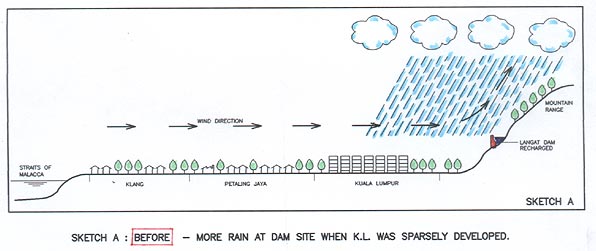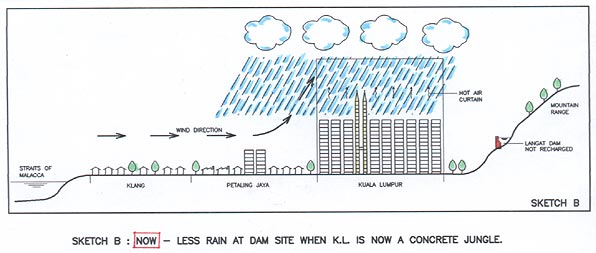

Like In Spain, The Rain Falls Mainly In The Plain
Rainfall records clearly show that in the past 12 years there had always been less rainfall recorded in Langat catchment area than in Petaling Jaya. This phenomenon is even more pronounced in recent years. (See Graph enclosed) Like in Spain, one can expect the Klang Valley to have more and more rains falling in the plain.
There are a number of plausible explanations for such a phenomenon. One is that the hot air curtain created by the ever-expanding concrete jungle in Kuala Lumpur had disrupted the atmospheric movement of wind coming from the Straits of Malacca.
In a normal course of a hydrologic cycle, atmospheric water vapor brought in from the sea to the hinterland is lifted by the mountain range and cooled. This cooling causes condensation and precipitation of the liquid in the saturated air and results in rainfall. The hydrologic cycle is complete when the water brought to the land is returned to the sea through runoff, evaporation and other processes.
When Langat Dam was built about 30 years ago, Kuala Lumpur looked more like a suburb of our capital city of today. There were many green lungs in and around the "town" and high-rise buildings were few and far in between. During those years, the atmospheric water vapor from the Straits of Malacca blew unimpeded across Klang, Petaling Jaya and Kuala Lumpur and finally was forced to rise due to the mountain range in the hinterland, and cooled the air sufficiently to produce precipitation. This brought an abundance of rainfall to the catchment areas in Langat and Klang Gates and the dams were recharged. (See Sketch A)

Sketch A
However, 15 years ago Kuala Lumpur started to change its skyline and slowly but surely it became a concrete jungle like what it is today. Congested with massive high rise buildings, choked with vehicular traffic generating heat and left with little green lungs, Kuala Lumpur City is now trapped in a massive hot air curtain. This massive curtain of hot air obstructs the flow of the water-vapor-laden wind coming from the Straits of Malacca and causes the latter to rise and results in heavy rainfalls in Kuala Lumpur and Petaling Jaya. This phenomenon deprives the catchment areas in the hinterland of the essential rain to recharge the dams. (See Sketch B)

Sketch B
The above phenomenon is prevalent during the inter-monsoon and S-E monsoon periods when the easterly or southeasterly winds blow inland from the Straits of Malacca.
Another reason for the higher rainfalls in Petaling Jaya and Kuala Lumpur is that due to the higher air temperatures and contents of condensation nuclei in the atmosphere in highly developed areas than in less developed areas.
The air temperatures in an urban area like Kuala Lumpur can be more than 3 Deg. C higher than in a greener area. The amount of water in the atmosphere is a function of temperature; the warmer the air, the more active its molecules, the greater its capacity for water vapor.
Warm air rises and its ascent is assisted by the convergence of wind flow at low levels from the surrounding areas. The precipitation process begins when the rising air expands and is cooled until it is saturated and the clouds are formed. These clouds are composed of water droplets formed by condensation or sublimation of water vapor on certain nuclei such as smoke and dust that are present in abundance in the polluted airs of Petaling Jaya and Kuala Lumpur. The water droplets grow and eventually precipitate as rain.
The current phenomenon of less and less rain falling in the catchment areas to recharge the dams will continue to worsen if developments in the Klang Valley continue unabated. Coupled with uncontrolled pollution of our waterways, water rationing may soon become a permanent feature of our water supply system in the Klang Valley.
To avoid a catastrophe the following actions need to be taken immediately:
• Stop development in and around the catchment areas
• Stop enlarging the concrete jungles of Kuala Lumpur and Petaling Jaya
• Preserve whatever green lungs we still have
• De-rate or down-rate the safe yields of existing dams and treatment plants
• Build additional dams elsewhere to supply the Klang Valley